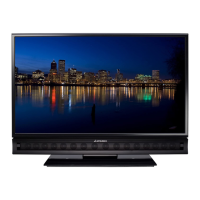
Do you have a question about the Mitsubishi Electric Unisen LT-52151 and is the answer not in the manual?
| Screen Size | 52 inches |
|---|---|
| Display Technology | LCD |
| Aspect Ratio | 16:9 |
| Brightness | 500 cd/m² |
| Viewing Angle | 178 degrees |
| Response Time | 8 ms |
| Sound Output | 10W x 2 |
| Resolution | 1920 x 1080 |
| Input Ports | HDMI, Component, Composite, VGA |
Lists all accessory items included with the TV for verification.
Instructions for inserting batteries into the remote control.
Step-by-step guide for installing the TV stand.
Information and contacts for wall-mounting the TV.
Preparatory steps before the first-time power-on.
Guide for initial TV power-on and welcome screen setup.
Overview of the remote control and its functions.
Details on the TV's control panel and system reset.
Guide for scanning channels and connecting external devices.
Explains auto input sensing and connecting devices.
How to watch broadcast TV and DVDs/videos.
Making picture and audio adjustments.
Overview of auto sensing and connection types for best quality.
Instructions for using cable ties for organization.
Diagram and identification of all TV connector panels.
Detailed explanation of various input ports like HDMI, Component, etc.
Details on IR-NetCommand, USB, LAN, and RS-232C ports.
How to connect component video devices for surround sound.
Instructions for connecting HDMI devices for audio/video.
Connecting devices with DVI output via HDMI.
Connecting antennas or direct cable TV service.
How to connect VCRs or devices with composite video output.
Wiring VCR/DVD recorder to antenna or cable outlet.
Wiring VCR/DVD recorder to a cable box.
Connecting an analog A/V receiver for audio output.
Connecting A/V receiver via HDMI for audio/video.
Connecting a subwoofer for enhanced sound.
Connecting devices that output only audio.
How to switch between different connected devices using the Activity menu.
Setting the TV to automatically turn off after a set time.
Displays channel information and program listings.
Selecting between TV speakers, AV receiver, or headphones.
Methods to control A/V receiver volume via TV remote.
Information shown on the TV screen when the INFO key is pressed.
Explains signal types and how to adjust picture aspect ratios.
Guides on connecting a PC via HDMI or DVI.
Adjusting computer video output and TV display formats.
Playing photos and music from a USB drive.
Navigating and setting up USB media playback.
Connecting a camera via composite video for playback.
Explanation of the TV's built-in surround sound system.
Recommendations for optimal TV placement for Sound Projector.
Manual adjustments for beam angles and levels in Custom Menu.
Using a microphone for automatic Sound Projector calibration.
Setup and requirements for VUDU streaming service.
Steps to start using VUDU and activating the account.
Overview of various remote control methods for home theater.
Overview of the main menu categories and their functions.
Explanation of how to navigate through the TV menus.
Settings for picture adjustments like mode, contrast, brightness.
Audio adjustments including speakers, subwoofer, bass, treble.
Audio settings for listen to, language, and level sound.
Picture settings like film mode, motion smoothing, and video mute.
Advanced picture settings like PerfectColor and PerfecTint.
Settings for displaying closed captions on analog and digital channels.
Setup for language, clock, timer, input, and channel scanning.
Channel scanning, editing, and energy usage settings.
Sound Projector setup modes (Auto, Manual, Custom).
Assigning names to inputs and managing NetCommand settings.
How the Activity menu is generated based on device usage.
Parental controls, time locks, and panel lock settings.
Detailed parental rating settings and TV content categories.
Time lock settings and other menu options for alternate ratings.
Introduction to NetCommand IR home-theater control feature.
How to connect and position IR emitters for device control.
Step-by-step guide to learning remote control commands for devices.
How to control devices using NetCommand.
Device-specific keys and MORE menu functions for NetCommand.
Chart of NetCommand specialized device keys and functions.
Switching audio and controlling A/V receiver power.
Setting up control for A/V receiver power and volume.
Automatic audio switching (audio or audio/video) from TV.
Automatic switching to surround sound device.
Automatic audio/video switching via HDMI connection.
Controlling devices connected to an HDMI A/V receiver.
Instructions for programming the TV remote to control other devices.
Detailed steps and codes for programming the remote control.
Programming codes for various audio, cable, CD, and A/V devices.
More programming codes for A/V, satellite, VCR, and DVD/Blu-ray players.
Additional programming codes for VCR, DVD, and Blu-ray players.
Further programming codes for DVD and Blu-ray players.
Final programming codes for DVD and Blu-ray players.
How HDMI Control (CEC) enables device interaction.
Connecting an A/V receiver and devices for HDMI control.
Resolving CEC conflicts and using HDMI control features.
Recommendations for cleaning the TV and remote control.
Instructions on how to bypass parental locks using a pass code.
Guide for resolving common TV problems using reset functions.
Troubleshooting for channel memorization, lock menus, and system reset.
Troubleshooting for VUDU, remote control, and CEC issues.
Troubleshooting for channel tuning, power issues, and timer functions.
Troubleshooting for picture quality and sound issues.
Troubleshooting for NetCommand IR control and A/V receiver sound.
More troubleshooting for NetCommand and A/V receiver audio/video sync.
